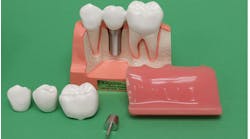Q: Recently, I heard a speaker talk about current malpractice risk, and his program frustrated me because it was far more complex than what I had heard before. One of his main topics was informed consent. For my legal protection, what do I have to do to have adequate informed consent?
A: In recent years, informed consent has become more complicated and detailed. Most lawyers involved with malpractice know the necessary characteristics of informed consent very well, but unfortunately many dentists don’t. To make your question easy to answer, let’s take an example of a dentist who provides no informed consent.
A male patient about 35 years old and in apparently good health came to our practice seeking a second opinion about another dentist’s proposed treatment. The patient was concerned that no other dentist had suggested such an aggressive, complex, and expensive plan. The patient had been told his teeth needed to be extracted because they were negatively influencing his overall health. The dentist suggesting the treatment proposed removal of all the patient’s teeth, placement of implants, and restoration of the edentulous arches with fixed prostheses.
Upon examination, I found the patient’s dentition to be relatively adequate, with only a few teeth needing restorations and removal of some remaining root fragments. I asked him if the other dentist had provided alternatives to total tooth removal, and his answer was no. The dentist stated his teeth had to be removed.
I provided a complete informed consent protocol for the patient, and he was shocked to hear about the other treatment alternatives that had not been explained to him, most of which were far less expensive and aggressive. He elected to have one of the conservative alternatives, and I referred him to a competent dentist in his town.
What are the components of adequate informed consent?
Read more from Dr. Gordon Christensen
Successful dental restorations: Tips from an industry expert
Has pulp capping been replaced by endo treatment?
Informed consent requirements
There are several requirements to ensure a patient has adequate informed consent. Using our example patient, I’ll review the characteristics of informed consent. Although the dentist told the patient he had to have his teeth removed, I would not have suggested this plan of treatment. Instead, I recommended restoration of the remaining teeth with fixed or removable restorations.
To easily understand this concept, I divide the informed consent discussion into the following six categories:
- Alternatives for care
- Advantages of each
- Disadvantages of each
- Risks of each
- Costs of each
- Result of doing nothing
Removable or fixed prostheses
Alternatives for care (figure 1)
A patient who has some restorable teeth remaining, controllable periodontal disease, and no interest in dental implants should be able to have either of these procedures done, if financial resources are available. The only major decisions are the materials used for the restorations and whether to use fixed or removable prostheses.
Here are the characteristics of fixed versus removable alternatives.
Advantages of each
- Removable restorations solve the esthetic challenges of missing teeth, and patients can appear as though they have all their teeth.
- Removable prostheses can be taken out of the mouth at will for cleaning and to allow hygiene on the remaining teeth.
- Removable prostheses are usually less expensive than fixed prostheses.
- Fixed prostheses are attached to remaining natural teeth and stay in the mouth all the time.
- Fixed prostheses replace the missing teeth with about the same contours and anatomy as the natural teeth. After a short time of having fixed prostheses, patients will often forget where they’re located.
- Fixed prostheses are stable and have no perceivable movement when chewing.
- The expected longevity of fixed prostheses is greater than that of removable prostheses.
- Fixed prostheses are much better accepted by patients than removable prostheses.
Disadvantages of each
- Removable prostheses with a metal framework rest on the remaining teeth. The dentist places small rest areas for the metal framework substructure on the teeth or crowns. Although stable when initially placed, removable prostheses become loose after time and need to be tightened.
- Occasionally, the metal clasps holding the removable prostheses in place break and need repair.
- Another type of removable prosthesis acceptable for only some clinical situations is made of flexible plastic. Although often more comfortable than metal-supported prostheses, these are not as stable and need to be replaced routinely.
- All removable prostheses move slightly when chewing.
- Fixed prostheses require the teeth supporting and retaining the prostheses to be trimmed significantly to allow a crown/cap to be cemented over the remaining tooth structure. Although this is not usually a problem, infrequently root canal treatment may be necessary.
- Fixed prostheses are more expensive than removable prostheses.
- After a period of use, the undersides of removable prostheses require relining to compensate for shrinkage of the underlying soft tissue and bone.
Risks of each
- Removable prostheses occasionally break and need repair or replacement.
- Removable prostheses can be lost or misplaced.
- If left out of the mouth, pets often destroy or attempt to eat removable prostheses.
- Fixed prostheses require removing tooth structure from the supporting teeth, which can infrequently require root canal treatment.
Costs of each
- Removable prostheses are significantly less expensive than fixed prostheses.
- Providing financial detail during the informed consent discussion is necessary since this is a major point in allowing patients to decide on their treatment method.
Result of doing nothing
- In our example case, the patient may have no problems other than the negative esthetic situation caused by the missing teeth.
- Because of the spaces between teeth, the teeth may move and cause malocclusion.
Who provides the informed consent information (see figure 2 above)
Although dentists are the ones legally responsible for the informed consent, educated staff members can provide this information, with the dentist coming in at the end of the consultation and summarizing it.
Documenting the informed consent
The patients, the doctor, and a witness (usually a staff member) should sign a paper or virtual validation that the dentist has provided the informed consent information. This verifies that the patient had the opportunity to make an educated choice from among the various treatment alternatives.
Summary
Providing informed consent educates patients and protects the dentist from potential lawsuits. Unfortunately, many dentists don’t complete the informed consent protocol, which makes them liable for potential legal challenges when patients claim they were not informed about some aspects of their treatment. Follow this information on the necessary content for informed consent for the benefit of all involved.
Author’s note: The following educational materials from Practical Clinical Courses offer further resources on this topic.
One-hour videos:
- Strong, Comfortable, Esthetic Rehabilitations with Zirconia (Item #V1942)
- Cementing Restorations—Proven & Successful (Item #V1921)
Three-hour virtual course:
- Removable Prosthodontics—Predictable & Enjoyable (Item #X2553)
Two-day hands-on courses in Utah:
- Simplifying Complex Treatment with Dr. Gordon Christensen
- Oral Surgery Secrets with Dr. Karl Koerner
For more information, visit pccdental.com or call Practical Clinical Courses at (800) 223-6569.
Editor's note: This article appeared in the July 2023 print edition of Dental Economics magazine. Dentists in North America are eligible for a complimentary print subscription. Sign up here.







